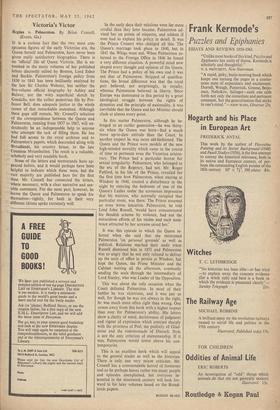Victoria's Victor
Regina v. Palmerston. By Brian Connell. (Evans, 42s.) IT is a curious fact that the two most con- spicuous figures of the early Victorian era, the Queen herself and Palmerston, have never been given really satisfactory biographies. There is no 'official' life of Queen Victoria. She is en- tombed in the many volumes of her published letters discreetly edited by Benson, Lord Esher and Buckle. Palmerston's foreign policy from 1830 to 1841 has been brilliantly analysed by the late Sir Cha'rles Webster, but neither the five-volume official biography by Ashley and Bulwer, nor the witty superficial sketch by Guedalla, nor the rather pedestrian life by Pro- fessor Bell, does adequate justice to the whole career of that remarkable statesman. Although these gaps still remain, Mr. Connell's selection of the correspondence between the Queen and Palmerston, running from 1837 to 1865, will un- doubtedly be an indispensable help to anyone who attempts the task of filling them. He has had full access to the royal archives and to Palmerston's papers, which descended along with Broadlands, his country house, to the late Countess Mountbatten. The result is a valuable, scholarly and very readable book.
Some of the letters and memoranda have ap- peared before, and it would perhaps have been helpful to indicate which these were, but the vast majority are published here for the first time. Mr. Connell has connected the letters, where necessary, with a clear narrative and sen- sible comments. For the most part, however, he leaves the Queen and Palmerston to speak for themselves—rightly, for both in their very different idioms spoke extremely well. In the early days their relations were far more cordial than they later became. Palmerston ad- vised her on points of etiquette, and seldom if ever had to explain his policy in detail. It was the Prince Consort who changed all this. The Queen's marriage took place in 1840, but in 1841 the Whigs went out. When Palmerston re- turned to the Foreign Office in 1846 he found a very different situation. A powerful mind now shaped every thought and opinion of the Queen. The Prince had a policy of his own and it was not that of Palmerston. Stripped of qualifica- tions, the broad difference was that the royal pair believed, not surprisingly, in royalty, whereas Palmerston believed in liberty. Since Europe was dominated in this period by a great ideological struggle between the rights of dynasties and the principle of nationality, it was inevitable that the Queen and her Minister should clash at almost every point.
In this matter Palmerston, although he be- longed to an earlier generation—he was thirty- six when the Queen was born—had a much more up-to-date attitude than the Court. In another respect he was more old-fashioned. The Queen and the Prince were models of the new high-minded morality which came in the course of time to permeate even the Victorian aristoc- racy. The Prince had a particular horror for sexual irregularity. Palmerston, who belonged to the era of the Regency, had not. Mr. Roger Fulford, in his life of the Prince, revealed for the first time how Palmerston, when staying at Windsor in 1840, created a disturbance in the night by entering the bedroom of one of the Queen's Ladies under the erroneous impression that his mistress, who normally occupied that particular room, was there. The Prince assumed an even worse intention. Palmerston, he told Lord John Russell, 'would have consummated his fiendish scheme by violence, had not the miraculous efforts of his victim and such assis- tance attracted by her screams saved her.'
It was this episode to which the Queen re- ferred when she said that she mistrusted Palmerston 'on personal grounds' as well as political. Relations reached their nadir when Russell dismissed him in 1851 and Palmerston was so angry that he not only refused to deliver up the seals of office in person at Windsor, but kept the Queen, the Prime Minister and the Cabinet waiting all the afternoon, eventually sending the seals through the intermediary of Lord Stanley, who was Leader of the Opposition.
This was about the only occasion when the Court defeated Palmerston. In most of their battles he was victorious, and it was just as well, for though he was not always in the right, he was much more often right than wrong. One comes away from this book with a higher respect than ever for Palmerston's ability. His letters show a clarity of mind, decisiveness of judgment and vigour of expression which contrast sharply with the prosiness of Peel, the prolixity of Glad- stone and the rodomontade of Disraeli. Style is not the only criterion of statesmanship. If it was, Palmerston would tower above his con- temporaries.
This is an excellent book which will appeal to the general reader as well as the historian. There is only one very minor criticism. Mr. Connell has a commendable hatred of footnotes and so he perhaps leaves rather too many people and episodes unexplained, but everyone in- terested in the nineteenth century will look for- ward to his later volumes based on the Broad- lands papers.
ROBERT BLAKE






































 Previous page
Previous page